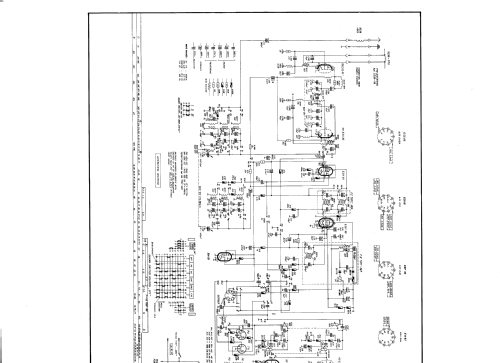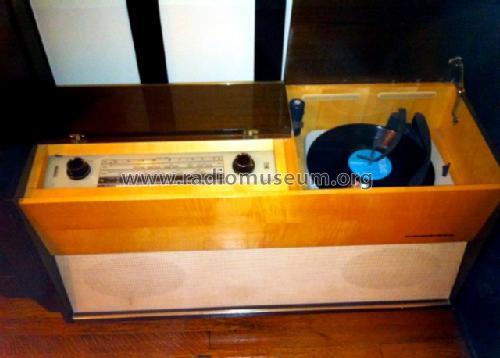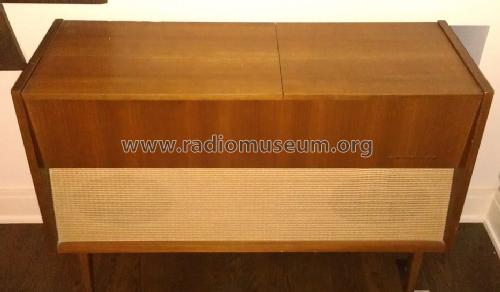Musikschrank SO302U/S
Grundig (Radio-Vertrieb, RVF, Radiowerke); Fürth/Bayern
- Hersteller / Marke
- Grundig (Radio-Vertrieb, RVF, Radiowerke); Fürth/Bayern
- Jahr
- 1962/1963
- Kategorie
- Rundfunkempfänger (Radio - oder Tuner nach WW2)
- Radiomuseum.org ID
- 89878
-
- anderer Name: Grundig Portugal || Grundig USA / Lextronix
Klicken Sie auf den Schaltplanausschnitt, um diesen kostenlos als Dokument anzufordern.
- Anzahl Röhren
- 6
- Hauptprinzip
- Superhet allgemein; ZF/IF 460 kHz
- Anzahl Kreise
- 6 Kreis(e) AM 9 Kreis(e) FM
- Wellenbereiche
- Mittelwelle, 2 x Kurzwelle plus UKW (FM).
- Spezialitäten
- Plattenwechsler
- Betriebsart / Volt
- Wechselstromspeisung / 110-220 Volt
- Lautsprecher
- 4 Lautsprecher
- Material
- Gerät mit Holzgehäuse
- von Radiomuseum.org
- Modell: Musikschrank SO302U/S - Grundig Radio-Vertrieb, RVF,
- Form
- Standgerät mit Drucktasten.
- Bemerkung
- Exportgerät.
- Literatur/Schema (1)
- -- Original-techn. papers.
- Autor
- Modellseite von Josef Pilz angelegt. Siehe bei "Änderungsvorschlag" für weitere Mitarbeit.
- Weitere Modelle
-
Hier finden Sie 6218 Modelle, davon 5451 mit Bildern und 4214 mit Schaltbildern.
Alle gelisteten Radios usw. von Grundig (Radio-Vertrieb, RVF, Radiowerke); Fürth/Bayern
Sammlungen
Das Modell Musikschrank befindet sich in den Sammlungen folgender Mitglieder.
Forumsbeiträge zum Modell: Grundig Radio-: Musikschrank SO302U/S
Threads: 3 | Posts: 31
I have had my stereo working well and went to finally do the refinishing of the cabinet. I had set aside the electronics during the process, but when I went to put everything back together, the volume level of the "stereo" setting is significantly lower. When I push the button for "mono", the sound is great.
I thought that this might be something simple since I had previously changed out all the capacitors and decided to check the resistors, which I had never investigated. I figured that something around the stereo/mono switch might be the problem.
I tested all the resistors and found a few slightly out of whack, but 3 in particular interested me:
R45 and R46 - Both are testing around 1.8k, while they should be at 3.9k. While this is odd, I focused my attention on the next issue, which seemed more pressing.
R61 should be 1k, but my multimeter showed 0 flat. I thought that this was odd, tested the same resistor 3 or 4 times in between testing other ones that all showed the correct value. Every time that I tested R61, it showed 0k.
I swapped out the resistor with a new 1k resistor, which I tested before installing and it read 1k correctly. As soon as I soldered it in, the reading on the multimeter showed 0 flat. Befuddled, I checked the resistor that I cut out and it read nearly a perfect 1k.
Completely confused, I turn to the group to see what I might be doing wrong. This might not even be the cause of my stereo/mono problem, but I need to start somewhere.
Thanks in advance!
Craig Vodnik, 06.Jul.13
I'm planning to refinish the cabinet on a Grundig 302 that has a wood veneer n particleboard. I'm planning to stain it darker than it currently is (you can see the photos of my console on the individual page) and I'm wondering if anyone knows what kind of wood veneer was used for these consoles.
Is there any standard way to tell what type of veneer for when choosing a stain? I have a few other radios and when I can save the finish, I will, but the boss (wife) wants it a more modern walnut color.
Any help is appreciated!
craig.
Craig Vodnik, 05.Dec.12
I've been reading about replacing the selenium rectifier in these late 50's, early 60's Grundig stereo consoles. I would like some assistance on getting the right parts.
Based upon the following schematic, you can see the rectifier

B250 C150 S u. H.
What would be the right silicon diodes to order to replace the selenium rectifier? Is there information on this diagram that I am missing that should give me the information that I need? Perhaps the B250 C150 notation?
What would you guess the drop in voltage is that I need to compensate for with an additional resistor? With respect to the resistor, let's say that the right answer is a 10 Ohm resistor. How do you determine the minimum wattage on it? Is it sufficient to say that 12 Volts over that 10 Ohm resistor means I need at least a 1.2 Watt, 10 Ohm resistor?
Thank you for any help that you can provide. I have a follow up question on R64 in the photo as well. How do I know what watt resistor I need? I see the voltage and capacitance on the electrolytic capacitors, but not sure if I can get the number that I need to rplace those electrolytics.
craig.
Craig Vodnik, 12.Nov.12






